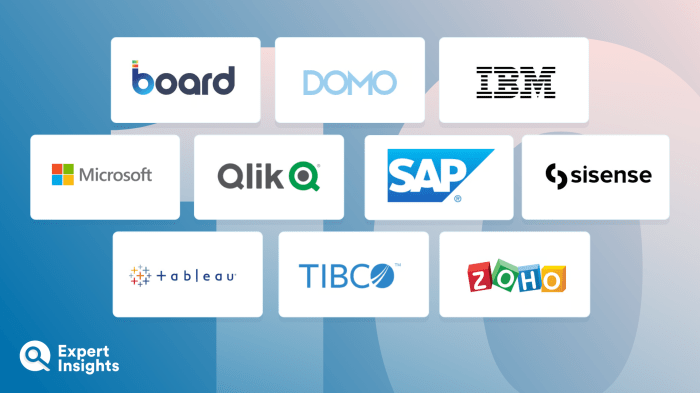Describe business intelligence and embark on an enlightening journey into the realm of data-driven decision-making. Business intelligence (BI) empowers organizations to harness the power of data, transforming it into actionable insights that fuel informed choices and drive business success.
Delve into the intricate components, diverse types, and multifaceted benefits of BI. Explore the challenges and emerging trends shaping the field, and glean invaluable lessons from real-world case studies.
This comprehensive guide will equip you with the knowledge and strategies to leverage BI effectively, unlocking a world of data-driven possibilities.
Definition of Business Intelligence
Business intelligence (BI) is a technology-driven process for analyzing data and presenting actionable insights to help organizations make informed decisions.
It involves gathering, integrating, analyzing, and presenting data from various sources to provide a comprehensive view of an organization’s operations.
Components of Business Intelligence
A comprehensive BI system consists of several essential components:
- Data sources: Data is gathered from various sources, such as internal databases, external data feeds, and social media platforms.
- Data integration: Data from different sources is integrated into a central repository to ensure consistency and accuracy.
- Data analysis: Data is analyzed using statistical techniques, data mining algorithms, and machine learning models to identify trends, patterns, and relationships.
- Reporting: Insights derived from data analysis are presented in reports, dashboards, and visualizations to facilitate decision-making.
Types of Business Intelligence

BI can be categorized into different types based on its purpose and functionality:
- Descriptive BI: Provides insights into past and present performance, helping organizations understand what has happened.
- Diagnostic BI: Analyzes data to identify the root causes of problems, enabling organizations to understand why things have happened.
- Predictive BI: Uses statistical models and machine learning algorithms to predict future trends and outcomes, helping organizations anticipate what might happen.
- Prescriptive BI: Provides recommendations on the best course of action, based on data analysis and optimization techniques, enabling organizations to decide what to do.
Benefits of Business Intelligence
BI offers numerous benefits to organizations, including:
- Improved decision-making: Data-driven insights empower organizations to make informed decisions that are aligned with business objectives.
- Increased efficiency: BI tools automate data analysis and reporting, freeing up time for employees to focus on more strategic tasks.
- Reduced costs: BI helps organizations identify areas where they can reduce expenses and improve profitability.
- Enhanced customer satisfaction: BI provides insights into customer behavior, enabling organizations to tailor products and services to meet their needs.
Challenges of Business Intelligence

Implementing and maintaining BI systems can pose several challenges:
- Data quality: Ensuring the accuracy and consistency of data is crucial for effective BI.
- Data integration: Integrating data from multiple sources can be complex and time-consuming.
- Skilled professionals: Implementing and managing BI systems requires skilled professionals with expertise in data analysis and technology.
Trends in Business Intelligence, Describe business intelligence
The field of BI is constantly evolving, with new technologies emerging to enhance its capabilities:
- Cloud computing: Cloud-based BI platforms offer scalability, flexibility, and cost-effectiveness.
- Artificial intelligence (AI): AI techniques, such as machine learning and natural language processing, automate data analysis and improve insights.
- Machine learning: Machine learning algorithms can identify complex patterns and make predictions based on data.
Case Studies of Business Intelligence
Numerous organizations have successfully implemented BI systems to improve their operations:
- Walmart: Uses BI to optimize inventory management, reduce costs, and improve customer satisfaction.
- Amazon: Leverages BI to personalize product recommendations, enhance customer experience, and drive sales.
- Netflix: Employs BI to analyze user behavior and tailor content recommendations, leading to increased engagement.
Best Practices for Business Intelligence
Effective implementation and management of BI systems require following best practices:
- Data governance: Establish clear policies and procedures for data management to ensure accuracy and consistency.
- Data security: Implement robust security measures to protect sensitive data from unauthorized access.
- User adoption: Engage users in the BI implementation process and provide training to ensure widespread adoption.
Final Review
In the ever-evolving landscape of business, data has emerged as a strategic asset, and business intelligence has become an indispensable tool for organizations seeking to navigate the complexities of the modern marketplace.
By embracing the principles and practices Artikeld in this guide, you can harness the transformative power of BI, empowering your organization to make informed decisions, optimize operations, and achieve sustainable growth.
Business intelligence (BI) involves gathering, storing, and analyzing data to provide insights that help businesses make informed decisions.
A key component of BI is the dashboard, a visual representation of key metrics and trends that provides a comprehensive overview of business performance.
Dashboards in business intelligence empower decision-makers with real-time data and insights, enabling them to identify opportunities, address challenges, and optimize operations.
FAQ Compilation: Describe Business Intelligence
What is the primary objective of business intelligence?
The primary objective of business intelligence is to provide organizations with data-driven insights that empower them to make informed decisions, improve operational efficiency, and gain a competitive edge.
What are the key components of a business intelligence system?
Business intelligence (BI) empowers businesses to make informed decisions by providing insights into data. For professionals seeking roles in BI, preparation for interviews is crucial.
To excel, candidates should familiarize themselves with common business intelligence interview questions that delve into topics like data analysis techniques, data visualization tools, and the ability to articulate BI’s value to stakeholders.
A comprehensive understanding of BI principles and their application in real-world scenarios will enable candidates to showcase their expertise and secure their desired positions.
The key components of a business intelligence system typically include data sources, data integration tools, data analysis capabilities, and reporting and visualization tools.
Business intelligence involves the collection, analysis, and interpretation of data to gain insights and make informed decisions. To enhance your knowledge and skills in this field, consider enrolling in business intelligence courses.
These courses provide comprehensive training in data analysis techniques, data visualization, and business intelligence tools, enabling you to leverage data effectively for strategic decision-making and improved business outcomes.
How can business intelligence benefit organizations?
Business intelligence can benefit organizations by improving decision-making, increasing operational efficiency, reducing costs, enhancing customer satisfaction, and driving innovation.




